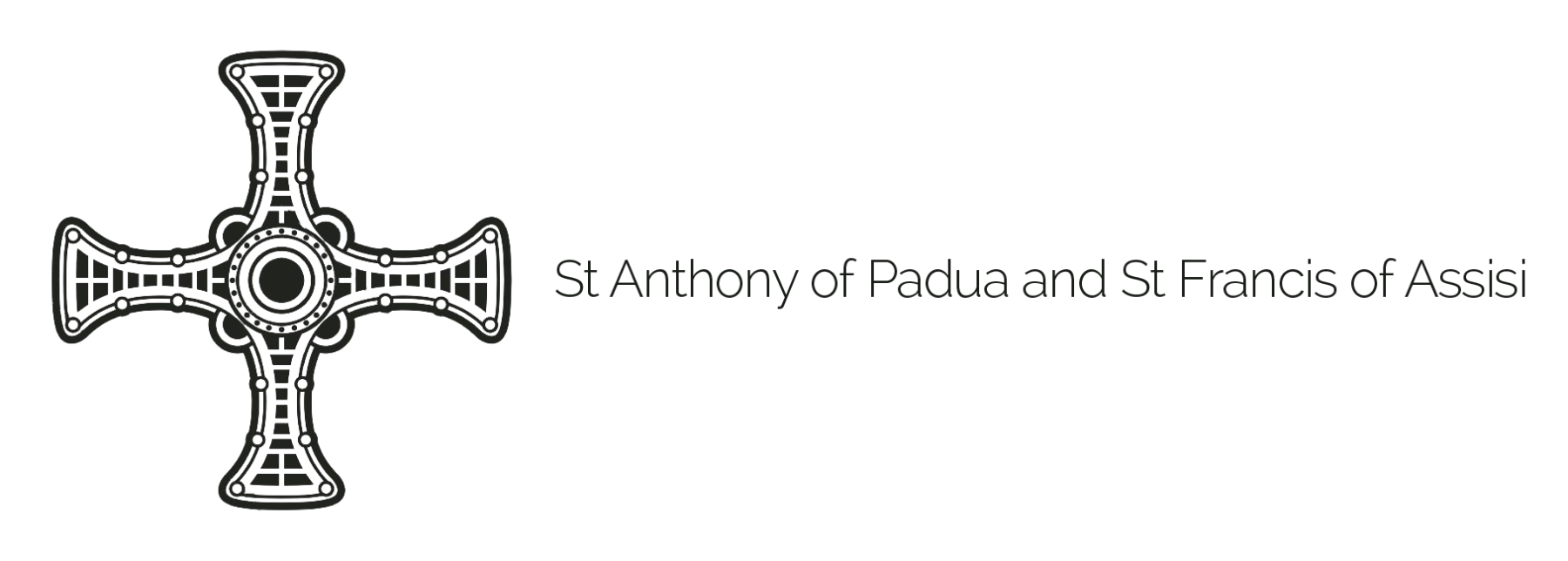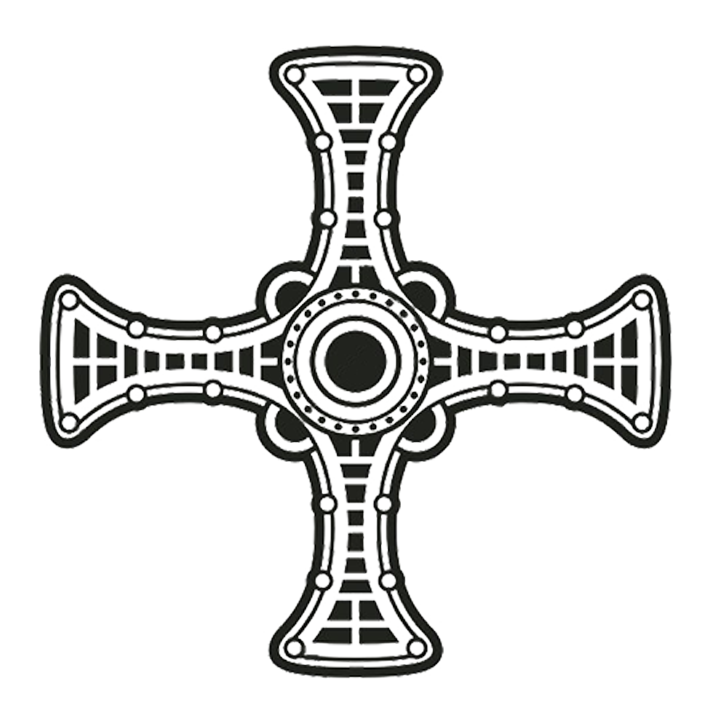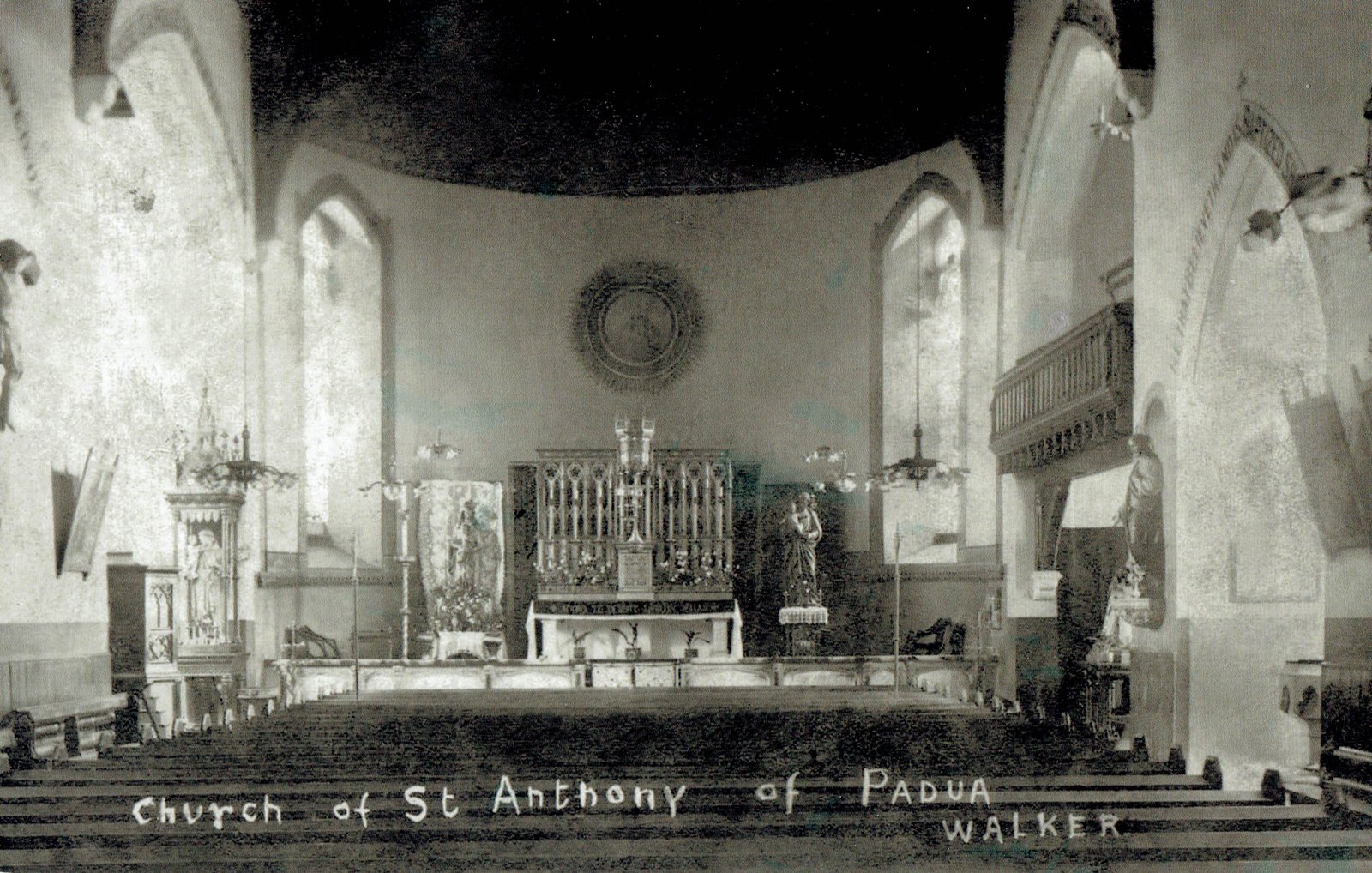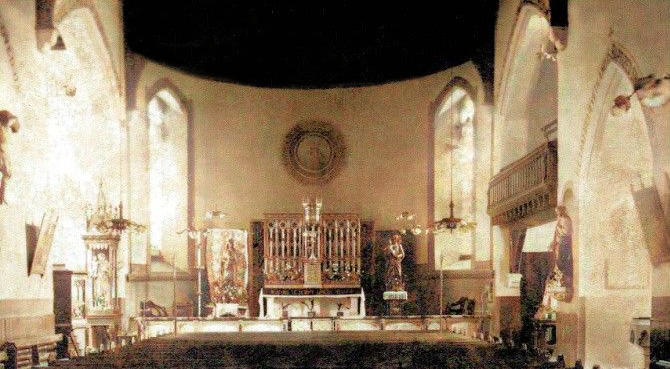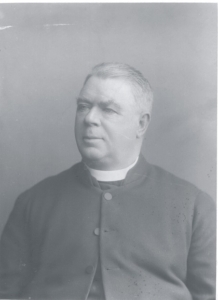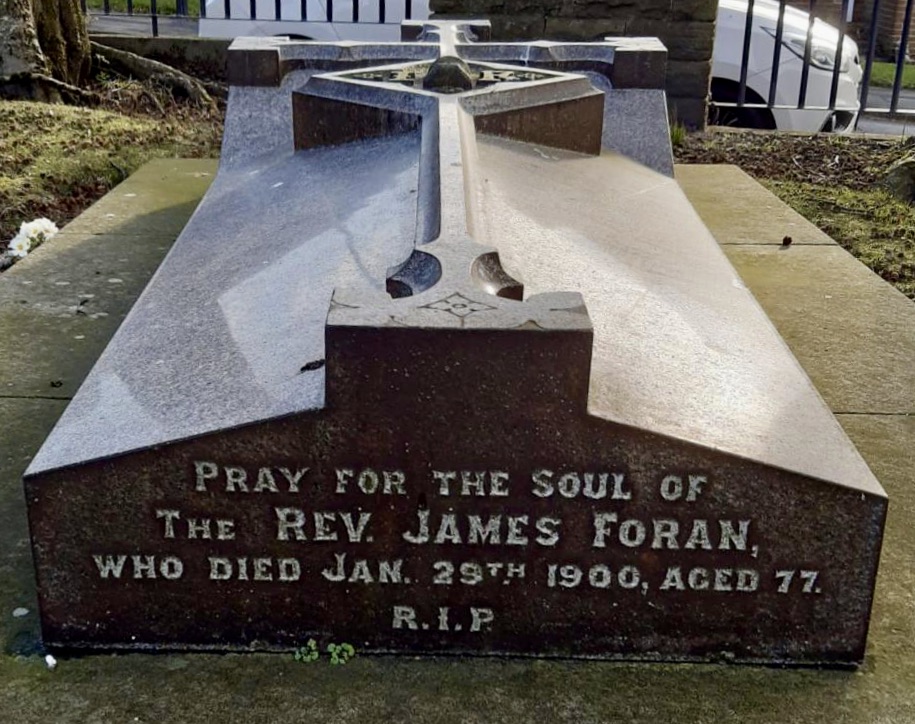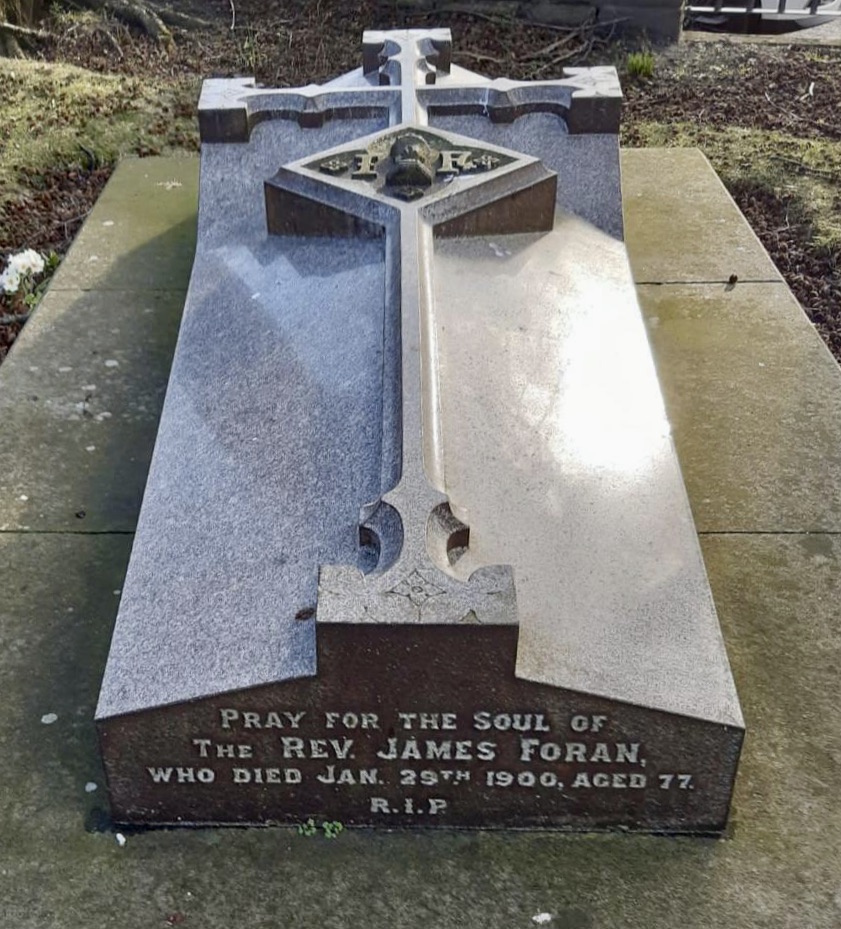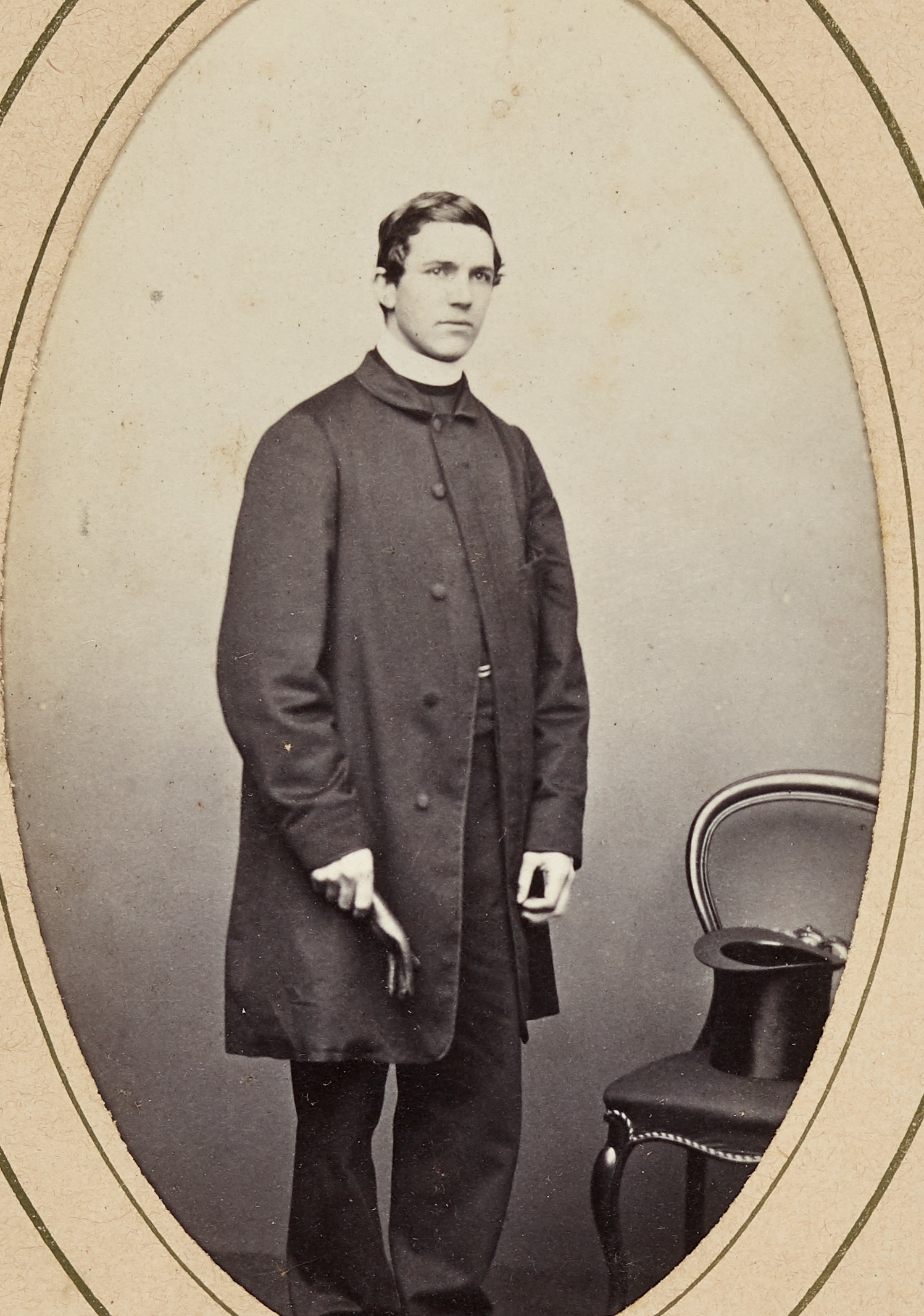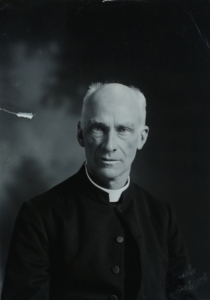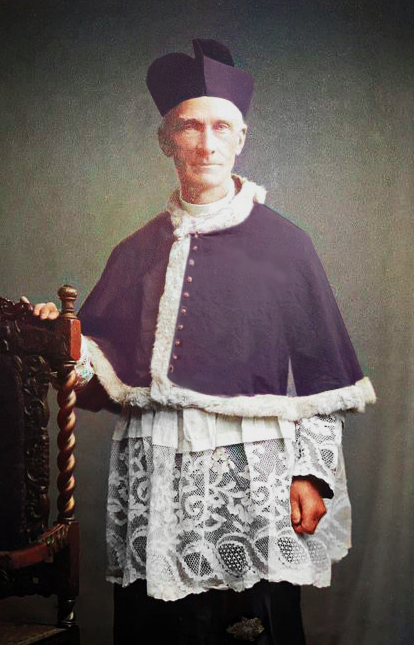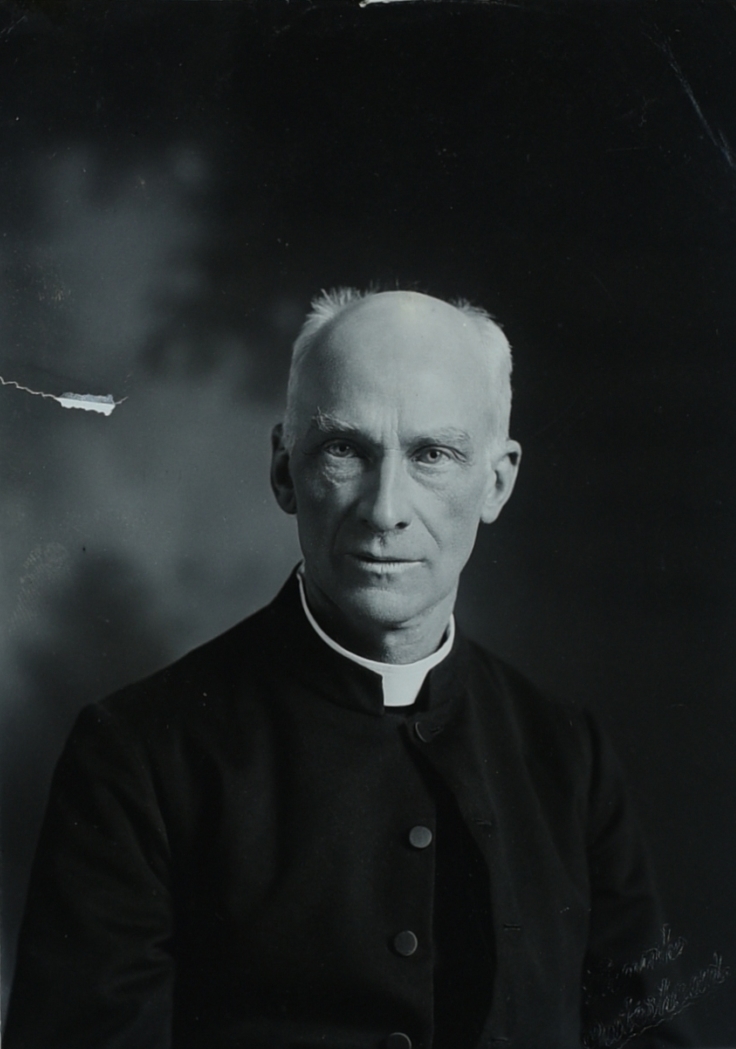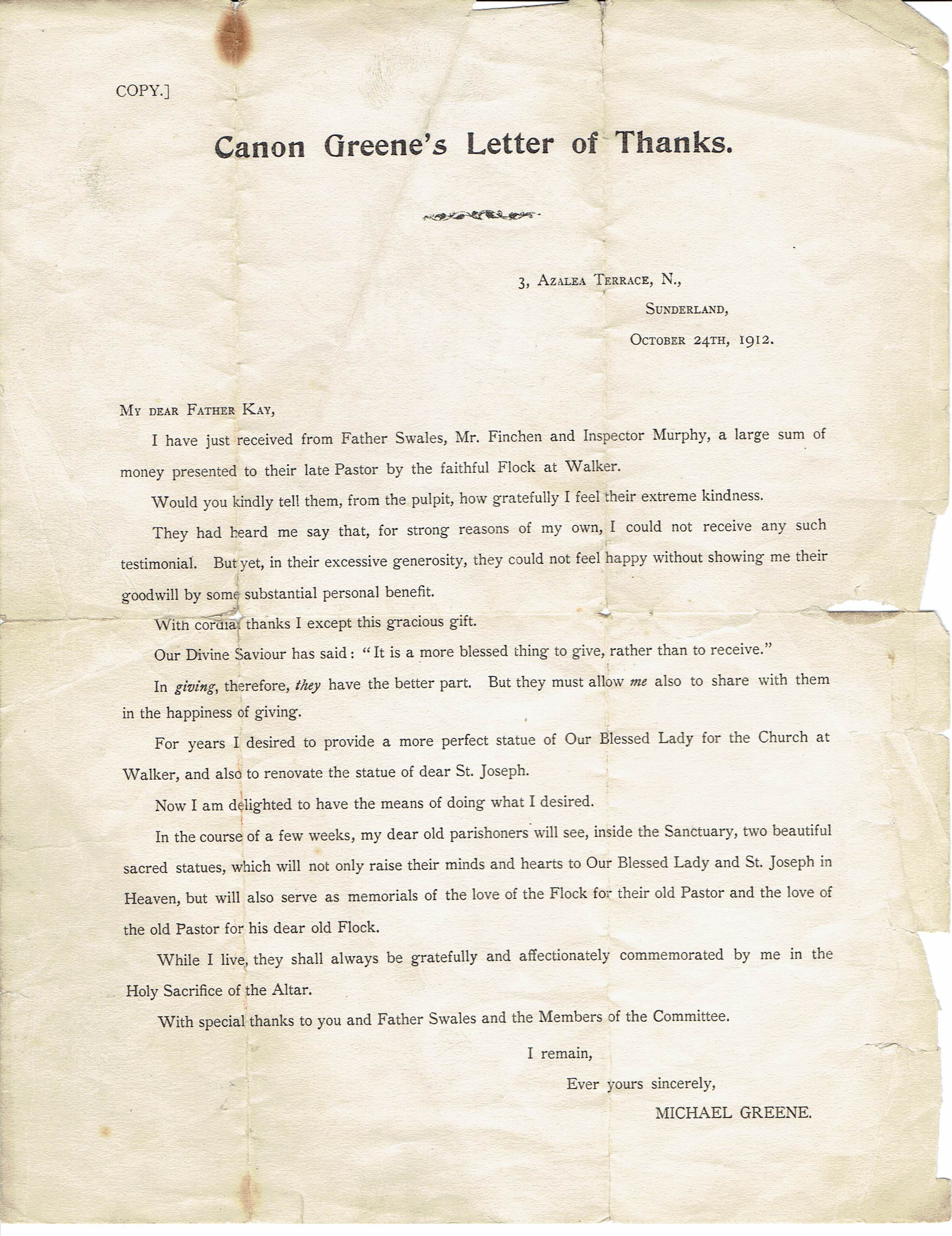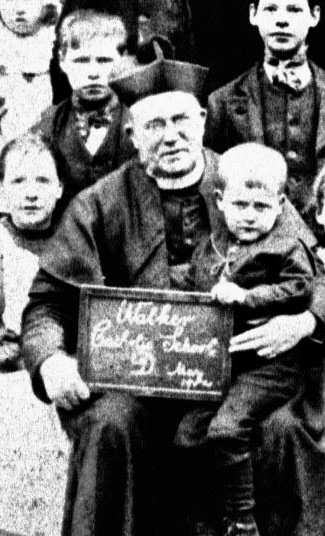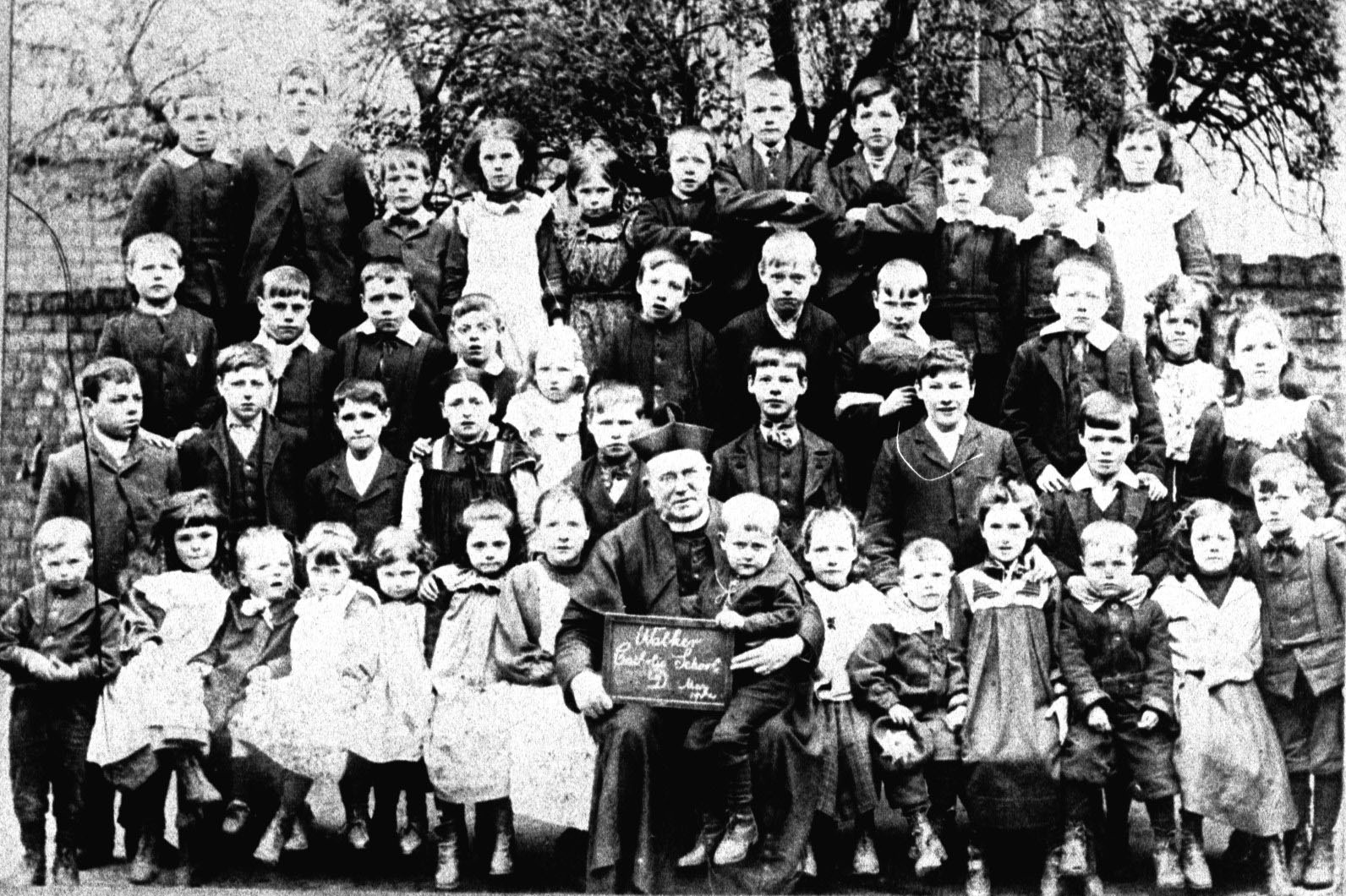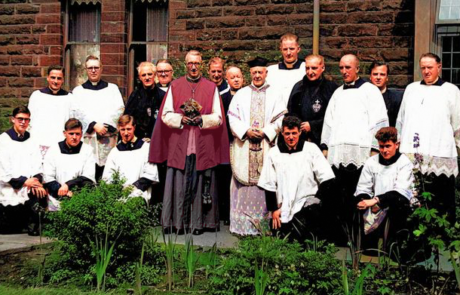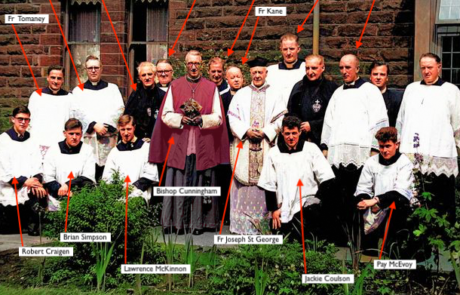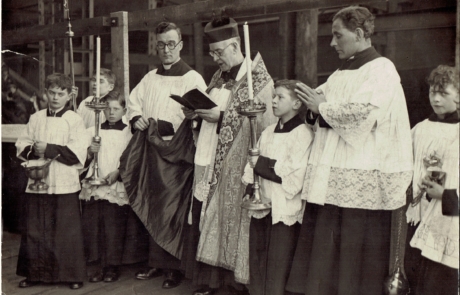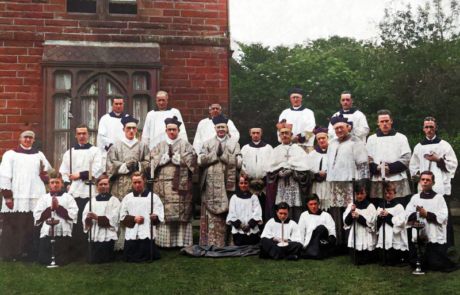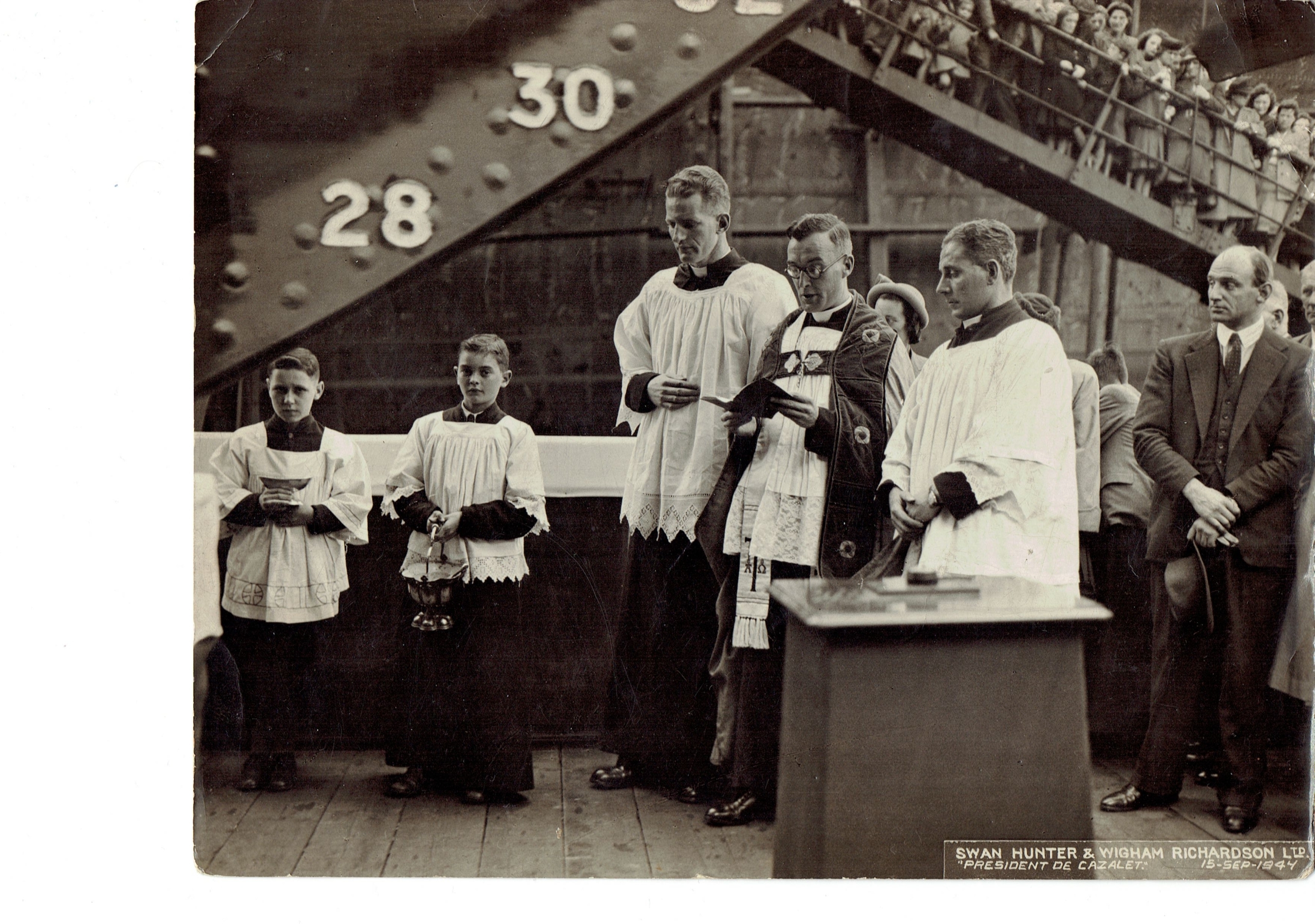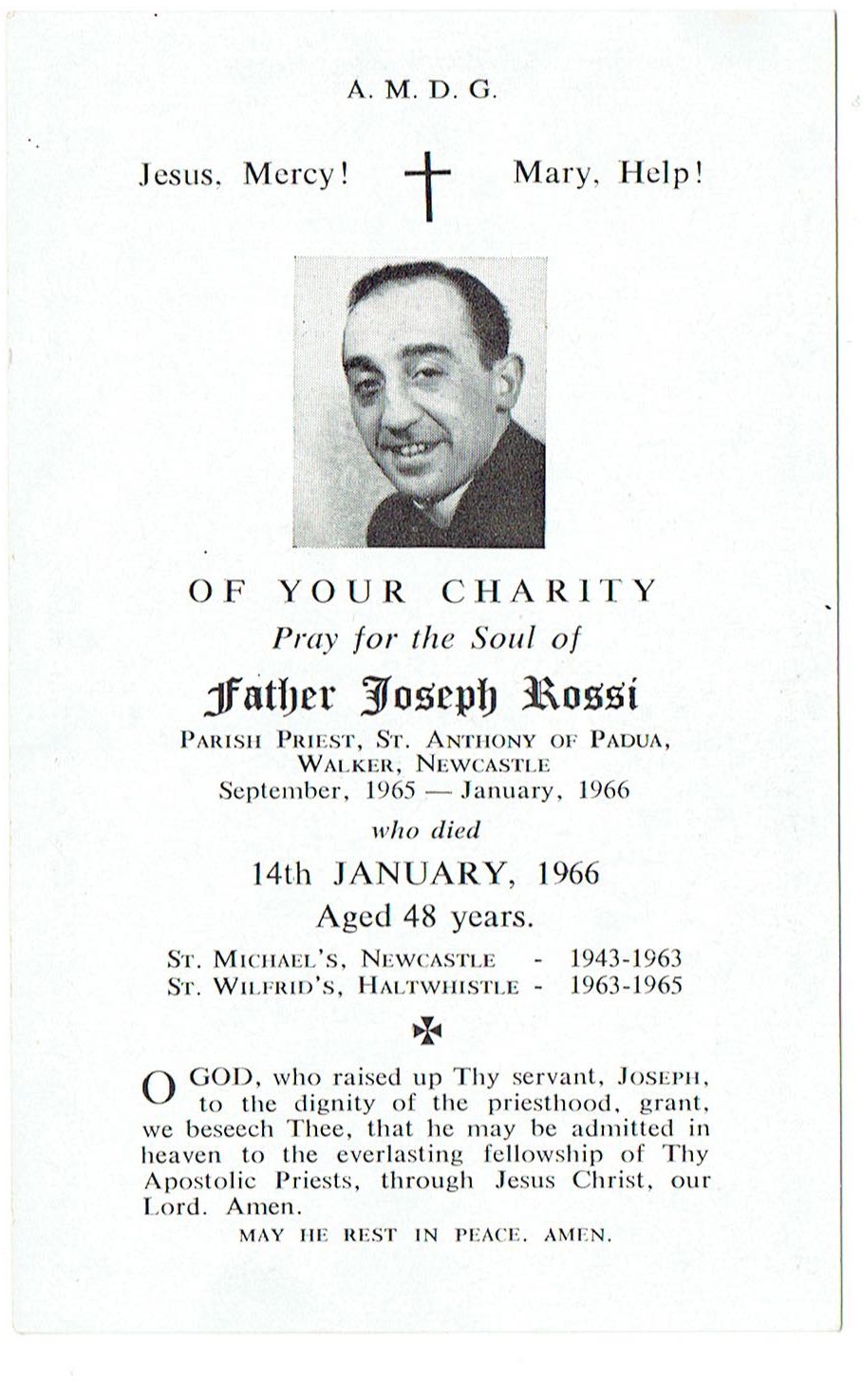A History of St Anthony of Padua Catholic Church
On Thursday 3rd November 1859, the ceremonial blessing of the foundation stone of a new Catholic Church took place in Walker, Newcastle upon Tyne. The Bishop of Hexham, William Hogarth, attended along with a number of clergy. Also in attendance was Rev. James Foran who was to become the first parish priest of the church in 1860.
The local iron works of Losh, Wilson and Bell employed a large number of Irish Catholics at this time and, because there was no church in the area, they were having to travel into Newcastle upon Tyne to attend Mass. Bishop Hogarth agreed to the opening of a new mission in Walker and the diocese purchased land from the Corporation of Newcastle. Archibald Matthias Dunn, a leading Catholic architect, was recruited to design the church and presbytery. It was built in the fashionable Gothic style of the time.
The new church was opened on 20th September 1860 and it comprised a nave, south transept and baptistry, completed at a cost of £1700. Later, a north transept and bell tower were to be added, taking the total cost to an estimated £2100. When opening the church, Bishop Hogarth advised his clergy that churches shouldn’t be expensive to build, and by building expensive churches it meant that some areas of the diocese were left without chapels at all. The church was 120ft in length, 31ft in width and the height to eaves 28ft. There was room for 300 seating and 150 standing. The church contained a high altar, the sanctuary was carpeted and the windows were of Hartley’s rough plate glass. The church was lit by gas. The presbytery had 5 rooms, a kitchen, a back-kitchen and a water-closet.
Priests who have served in St Anthony of Padua
1860 – 1875
James Foran was born on 5th December 1823 at Whitfield, near Tramore, County Waterford. He went to the Latin school in Carrick-on-Suir, followed by 4 years in St. John’s College, Waterford and 4 years at St. Patrick’s College, Maynooth.
He was ordained priest in Waterford on 10th November 1855. He immediately moved to the Diocese of Hexham and Newcastle and joined his elder brother, Father Robert Foran, working with Irish immigrants in the parish of St Andrew’s Catholic Church, Worswick Street, Newcastle upon Tyne.
After three years his brother was recalled to Waterford, but Fr James refused to follow him back to Ireland. He was serving in the old parish of St Andrew’s, his territory stretched east along the river Tyne to St. Cuthbert’s, North Shields, where the priest there was Father William Bewick. Fr James would often have to walk up and down through Walker to Wallsend, and even up to Benton to catechise the people and visit the sick.
The population in Walker increased because of the development of the coalmines, chemical works, ironworks and shipyards along the riverside in St. Anthony’s. Catholics found it difficult getting to Mass and receiving the Sacraments. It was at this time Bishop Hogarth agreed to establish a new parish. Land was bought from the Newcastle Corporation which owned the Walker Estate and Fr James Foran was appointed as Parish Priest. Soon after this he had built the Church and presbytery and within 5 years he had built a school.
In 1868, Father Foran described the extent of the parish, pointing out the main areas where Catholics lived; High and Low Walker, Bill Point, St. Anthony’s, Byker and Byker Hill, Bigges Main and Billy Pit, and Little Benton. He estimates the overall population at 10,000 with 2,372 Catholics and rising. There were around 140 baptisms each year and just under 1000 Catholics fulfilled their Easter Duties. The schools accommodated 124 boys and 126 girls, there were Sunday schools and Night schools for both boys and girls. Many of the 11 and 12 year olds were going out to work.
On Sundays and Holidays there were Masses at 8:00am and 10:30am, with Evening Service at 6:30pm. Mass was at 8:15am on weekdays, with Rosary and Benediction at 7:30pm on Thursdays.
Father James became aware of a small community of Catholics on the Falkland Isles and he appealed to the Bishop of Hexham and Newcastle, Bishop Chadwick, to be allowed to work there. Bishop Chadwick reluctantly agreed to release him. Cardinal Manning petitioned Rome and it was agreed he could serve the Islands and would be given means to buy altar requisites and a passage to Port Stanley.
In his journal Father Foran wrote, “Although I knew nothing of these islands save their existence I had a longing for the place some years before I took the resolution of coming here. I was prompted by this step by learning accidentally that there were a number of catholics here without a priest. I with some difficulty obtained the leave of my Bishop.”
He writes of his departure: “I left Walker at 12:30 on Friday, the 17th September 1875, on my journey to the Falkland Islands. The night was very bright and a placid moon lighted our path as I, in company with my old and valued friends, James Frazer and Michael Ryan, passed along Byker path to Newcastle. I left in my house another dear little friend, Samuel Hawkins, to keep company with my sisters, Jane and Margaret, who had hitherto been my servants. My poor little black dog, Prince, ran out as usual with his master, but was driven back, never perhaps to see his master again.”
“I have often wondered how cooly and quietly I took my departure, fully aware of the ‘breakers ahead’, which at that distance seemed to have no terror for me. I am full of sadness now that I have just arrived at my destination.”
Before leaving England, Father Foran was warmly received by Cardinal Manning. He set sail from Southampton on board the S.S. Guadiana.
Voyaging south he recorded in his journal his new experiences – visits to ports, sightings of shoals of dolphins and flying fish, the rising of new constellations, temperature changes. Spanish and Portuguese passengers attended his shipboard masses.
He called at Rio de Janeiro and then at Montevideo where he met an Irish priest, Father Kirwan, “an old man and a fine fellow” who had spent four months on the Falklands twenty years before.
Putting out to sea again, this time of the Black Hawk, Father Foran journeyed on. On 3rd November he sighted the Falklands and wrote: “The desires of past years are now accomplished. How often have I wished that I should be favoured with a sight of this country! It is the will of God that my wish should be complied with, and may He grant that my arrival and ministration here may be for His honour and glory and the salvation of my own soul and the souls of others. Deo Gratias.”
The Governor, Colonel D’Arcy, though not a Catholic, welcomed Father Foran most hospitably to Stanley insisting he stayed at Government House until he could find his own accommodation.
Father Foran noted his first impressions: “The appearance of the surrounding country is as bleak as anything can be. No tree, no green grass, although this month corresponds with May in Ireland. The weather is fine for Falkland weather, but it is much colder than May in Ireland. The Catholics of the Islands number only about 150. The chapel is a wooden building, 33 feet by 18 feet, and of proportionate height. It is very handsomely built and furnished.”
In a letter to Cardinal Franchi, he comments: “I find a great apathy on religious matters here. The families with few exceptions are mixed marriages. In many instances the female children follow the religion of their mothers, and the males that of their fathers. Some have also gone over to the Protestant Church who once practised our holy religion.”
Father Foran writes in another letter that “the rule up to this time was that the Archbishop of Buenos Aires sent a priest to this place once in seven years.”
Father Foran’s congregation in the Falklands entered on Catholic Irish pensioners and their families among the colonists sent out by the Government in 1849. He spent his days celebrating Mass, preaching, forming a communion class, baptising and opening a Sunday school in Stanley. On his journeys through the islands by schooner and on horseback he administered the sacraments and said Holy Mass in the farm houses, visited sick and injured seamen on board their ships, and won back souls to Christ.
The congregations were poor and dispersed so Father Foran had to seek financial support from the Association for the Propagation of the Faith who gave him a grant of £100. The Colonel Office later granted him an annual salary of £50. Two good catholic families arrived, that of the new Governor Mr G Callaghan, and the new colonial doctor, Dr Mulvany. Father Foran’s life in the South Atlantic continued to bear witness to his Walker parishioners’ view of him as a ‘simple, earnest and contented soul.’
In October 1879 he wrote to the Association for the Propagation of the Faith with an idea which was to be carried out with great success in later years: “It was and is my great desire to succeed in placing this mission in the hands of some missionary society which could send two priests and a lay-brother to reside there. I had also a hope that if a missionary society took charge of this mission, such might begin a mission among the Patagonians or the Fuegians who inhabit the islands south of the Straits of Magellan. These latter islands will be a fertile field for missionary labour. Having before may mind the hopes I have now given expressions to, I secured 1.5 acres of land in Stanley in a good situation and fenced all around. It is a good position for a church, presbytery, convent, school and garden.” By August 1880 he was able to open the new school with 6 scholars. Intriguingly, the teacher in charge was called Samuel Hawkins. When Fr Foran left Walker in 1875 he had “left in my house another dear little friend, Samuel Hawkins, to keep company with his sisters, Jane and Margaret, who hitherto been my servants.” Could this be the same man? Were there emigrants from Walker to the Falklands?
From 1881 onwards Solitude and the harsh climate persuaded Fr James to divide his time between his mission in the Falklands and the extensive Irish community in Argentina. He met with great kindness from a number of fellow Irish priests and was very happy for the next five years, travelling among the farmers of the Plate, and backwards and forwards to the Falklands by way of Buenos Aires, Montevideo and Sandy Point. However, in June 1885 one of Fr Foran’s letters shows that he was ready for a return to England, “Considering my age, I count that four or five more years would be as much as I could labour in this country. Then I shall be thrown on the shelf without any provision for old age. In England it is very different; old and infirm priests are amply provided for. At all events, the work for which I came to the Southern regions is done.” In 1885 he laid the foundation stone of a new church in Port Stanley, but he had already put this property into the Trusteeship of the Bishop of Hexham and Newcastle, expecting that it would soon be transferred to the Salesians who had promised to send priests. The Salesians did not come, so Father James decided to go to Rome to hurry them along. First he went for a farewell tour, sailing to Chile, celebrating Mass on a beach in Terra del Fuego, saying goodbyes to friends in Buenos Aires, and then setting sail for Naples and then Rome. Fr James wrote reports on his missions in the Falklands and Argentina, and called in on the Irish College in Paris.
In 1886, Bishop John William Bewick appointed Fr James to succeed the late Fr James Smith (who died 3rd August, 1885) as Rector of St. Mary’s Church, Blackhill, County Durham. Fr Foran was still worried about his former parishioners in South America and wrote to Don Bosco of the Salesians, reminding him of his promises. An Irish Salesian was sent to Port Stanley in the summer of 1888. In 1889 Fr James was appointed Rural Dean of Benfieldside, which comprised the parishes of The Brooms, Byers Moor, Stanley, Tow Law, Westwood and Blackhill. He also founded Catholic Institutes at Blackhill and Consett and was a member of the Consett and District Nursing Association.
Father James served in Blackhill until the end of January 1900. He celebrated 8:00am Mass as usual on Sunday 28th January along with his curate, Father John Kelly. That night Fr James suddenly took ill and the sacraments were administered to him by Fr Kelly. He passed away peacefully at 5:30am. Fr James’ funeral was held at Blackhill on Thursday 1st February. He left his affairs in good order, and his Will shows a continuing concern for his old parish in Walker: ‘I give to the priest for the time being in charge of the Mission of Saint Anthony of Padua, Walker on Tyne, to be used and devoted by him for the purposes of the Mission one set of white satin vestments, one set of green Damask vestments, one set of red Damask vestments.’ He gave his telescope and lithograph of St. Anthony to his nephew, a priest in Wexford. He gave his Guanaco Rug, a souvenir of South America, to a niece in Tramore, County Waterford, together with his gold watch, silver forks and spoons. Fr James Foran is buried at St. Mary’s Catholic Church, Blackhill, County Durham.
1875 – 1878 and 1883 – 1904
Father Henry Francis Berry
Henry Berry was born in Colaba, Near Bombay, India on 10th December 1843, the eldest of six sons. His father was Major Henry Berry of the 26th Regiment of Foot, popularly known as the Cameronians. Henry was sent to Ushaw College at the age of 9 after his parents had been posted abroad. He was to stay at Ushaw for 21 years. He was a very successful and committed student. He excelled in the Classics and his French was so good he was sent to Paris to perfect it.
Henry Berry was ordained a Priest in 1868 and stayed on at Ushaw for another 6 years to be Professor of French and Prefect of Discipline. In 1873 he left Ushaw, going to St. Mary’s Cathedral in Newcastle and was to stay there until 1876 when he took charge of St. Anthony of Padua after Father James Foran moved to the Falkland Islands.
In 1878 Father Berry was transferred to St. Andrew’s Church in Newcastle, a new church and presbytery on Worswick Street replacing the old chapel in the gardens behind Pilgrim Street. He also served as Dean. He built new schools on the south side of the street and persuaded The Sisters of St. Paul the Apostle from Selly Park, Birmingham, to take charge of them. He introduced an organ into St. Andrew’s. He won such affection in Newcastle that when he left St. Andrew’s there was a presentation in Newcastle City Hall, he was presented with a purse of gold and an illuminated scroll “on his leaving the city” – he was returning to Walker.
In June 1883 Father Berry returned to St. Anthony’s and he remained there until his death in 1904. After returning to Walker, Father Berry installed three stained glass windows, a number of new statues and a pedal organ. He installed electric lighting in the church, presbytery and schools. A new infant school was built at a cost of £1300 and the other schools were enlarged to cope with the increasing population.
For a number of years Father Berry continued to teach at St. Cuthbert’s Grammar School as Professor of French. He served as Secretary for the Grammar School, conducting negotiations with school boards.
During his time at St. Anthony’s, Walker was not part of Newcastle upon Tyne. Walker was in Northumberland and came under the County Council. The Poor Law was administered by the Tynemouth Board of Guardians and schools were under the supervision of the Longbenton School Noard. Roads and other local services were provided by the Walker Local Board, this grew into the Walker Urban District Council. Father Berry served on all these public bodies as an elected member. He was also Chairman of the Walker Urban District Council until March 1904. This authority was responsible for installing street lighting, encouraging tramways, building a refuse incinerator and creating Walker Park, a large recreation area in the middle of the town. Newcastle was keen to increase its rates income and wanted to absorb Fenham, Benwell and Walker into the city. These areas were all growing, particularly Walker and Benwell as they were the industrial bases of industrial prosperity. People in these areas were happy to stay as they were, they were concerned that if they became part of the city, rates would rise and their influence on making decisions would diminish. There were public meetings, debates in the newspapers and lawyers were engaged to oppose the Extension Bill in Parliament. Father Berry was very involved with this and he was called to London to give evidence during the Committee stages of the Bill in Parliament. Newcastle City Council argued that its population had spilled over into Walker, so it was only right that the City should absorb the area and gain the benefits. Father Berry and Walker Urban District Council argued that, in fact, its industries had led to population growth and prosperity, and Walker folk had actually spread into Newcastle. Father Berry put forward that Walker would not benefit from this proposal. Walker had its advantages – Walker had an up-to-date refuse destructor, Newcastle’s was old and antiquated. The back streets in Walker were asphalted and lit by electricity, Newcastle’s were not. There were no guarantees that the money would be spent in Walker. Repairs would be carried out by Newcastle but only on a small scale.
On 9th November 1904 Walker lost this battle and became part of the city of Newcastle upon Tyne.
Father Berry died on Tuesday 20th September 1904. His funeral was reported in the Daily Chronicle as a scale unusual for a Catholic Parish Priest, “The affection that was borne towards the deceased priest was evidenced in the signs of sorrow that were shown in the township and the city, and in the great crowds of people who gathered to witness one portion or another of that last sad ceremony. The funeral was the largest ever seen at Walker, many being unable to gain admission to the church. There were about 100 mourning coaches and private carriages present. About 70 Catholic Priests attended.”
The procession included relatives, clergy, acolytes, nuns, councillors, teachers, twelve underbearers from the congregation. It made its way from Walker to Ashburton Cemetery, Gosforth, where the mortal remains were interred in his mother’s grave, under this inscription:
“Pray for the repose of the soul of Reverend Dean Henry Francis Berry of St. Anthony’s, Walker on Tyne, died September 20th 1904 aged 60 years.
MOST GLADLY WILL I SPEND AND BE SPENT MYSELF FOR YOUR SOULS.”
Photograph of Father Berry reproduced by permission of Durham University Library.
1878 – 1880
Father John McNerney
1880 – 1881
Father Conrad Kaelin
1881 – 1882
Father James Corboy
1882 – 1883
Father M.T. Bourke
1904 – 1912
Canon Michael Greene
Father Michael Greene came from Wexford, Ireland. He was ordained in 1867 and moved to the Diocese of Hexham and Newcastle. He served in Darlington, Seaham and West Hartlepool – all growing industrial towns. By 1885, his health was already suffering and he was sent to the relatively new Parish in Chester-le-Street (1881). Soon after this a vacancy arose in South Shields and Father Greene was asked to move to this Parish where he would be responsible for approximately 6000 people.
In 1891 Father Greene was appointed Canon, and in 1894 he moved to St. Joseph’s in Gateshead where he would spend ten years before moving to St. Anthony’s in 1904. This was a time of momentous change in Walker. The Walker Urban District Council wads dissolved, and Walker was now part of Newcastle upon Tyne. Soon the Council was planning on building cottages in a “garden city” on 16.5 acres of the corporation estate. From 1908, 454 dwellings were provided and let at rentals varying from 2s.3d. to 9s.3d. a week. Only 72 of the 454 had more than 2 rooms; the majority only having one. There weren’t a great success and contributed little to the reduction of overcrowding in Newcastle. At that time the average number of persons to a dwelling in Newcastle was 8.13.
In 1904 Canon Greene was assisted by Father Nicholas Hennessy. On Sundays and Holy Days there were Masses at 8.00am, 9:15am and 11:00am. Benediction on Sundays was at 3:00pm (for children and supported by Catechism and Religious Instruction) and 6:30pm, on Holy Days it was 7:30pm. There were confraternities for the laity: St. Joseph’s Confraternity for children from 6 to 15 years, for everyone else there was the Confraternity of Our Lady of Compassion for the return of Great Britain to the Catholic Faith; Confraternity of the Sacred Heart; Confraternity of the Immaculate Heart (each separate for men and women). These confraternities had monthly ‘General Communion Days’. From 1902 there had been a Catholic Men’s Club and there were Whist Drives to raise funds. Canon Greene and Father Hennessy were Chaplains to Walker Hospital and the Walker Fever Hospital.
Canon Greene was keen that Catholics should have “interesting and useful reading matter available. He encouraged people to buy a “Catholic paper or that beautiful monthly, The Messenger of the Sacred Heart, or some interesting lives of the saints which may be read with great pleasure and profit” – available from the CTS. The year was measured out according to the liturgical seasons, and Catholic distinctiveness was reinforced by regular fasting and abstinence, especially on quarterly Ember Days (the days at the beginning of the seasons ordered by the Church as days of fast and abstinence), and by the encouragement of alms-giving, generally to support those in Catholic institutions. For example, during Advent, children were to give pennies and halfpennies “for the orphan children in the Catholic Homes at Gainford and Tudhoe.”
A typical Advent or Lent exhortation would be “At this season the Church of God calls upon us to rouse up our souls, to correct our faults, to pray more fervently, to do penance for the past, to confess our sins with sincere repentance and to receive Holy Communion for our spiritual and eternal welfare.” Perhaps because of more stringent fasting rules, or a stronger sense of sin, few people went to Communion than nowadays.
Christmas 1906 was to be a joyful festival, but the priests were not too keen on alcohol. Each year their warnings were repeated: “We earnestly exhort our people to Christian sobriety. Let no member of our flock profane Christmas by drunkenness. Whatever others do, let no Catholic be guilty of such a sin and such a profanation. Any Christian who gets drunk at Christmas is guilty of a base insult to his Divine Redeemer.” There were six Masses: Midnight Sung Mass, 8:00am, 8:30am, 9:15am children, 10:00am, and 11:00am Sung Mass with a sermon. In the evening of Christmas Day there would be the Rosary with a Sermon, Procession of the Blessed Sacrament, and Benediction. “Girls dressed in white will take part in the procession.” This was a recurring announcement.
1902 – 1904
Father William O’ Hagan
Photograph of Father William O’Hagan and pupils from Walker RC School 1904 reproduced by permission of Newcastle Journal and Evening Chronicle.
1905 – 1907
Father Nicholas Hennessy
1908
Father John Fleming 1908
1909 – 1912
Father George Swales
1912 – 1926
Father James Kay
1916 – 1917 and 1932 – 1965
Father Joseph St George
Father St. George is the only Parish Priest of St Anthony’s to be born in the parish, so far. He was the seventh child of Thomas and Mary St. George, who lived at 9 Church Street, Walker. Thomas moved to Newcastle from Kilkenny, Ireland, having married Mary, who was from Cork. Thomas worked as a Caulker in the shipyards. Joseph went to Ushaw College and was ordained on 19th July 1908. Fr Joseph served as a Curate at St. Joseph’s, Hartlepool; Our Lady, Easington, and then moved to St Anthony’s from June 1916 to May 1917. He joined the Army as a Chaplain and served throughout the First World War. After the War he moved to St Wilfred’s, Haltwhistle in 1920. After 5 years in Haltwhistle, he moved on to be the first Parish priest of St. Joseph’s, Coundon. In November 1931 he came to St Anthony’s as Parish Priest and remained here until his death in July 1965.
Fr St. George directed a succession of talented and hardwired curates – about 17 of them across the years. There would usually be 5 or 6 Masses every Sunday.
The priests in Walker played a great role in supporting their parishioners through the Second World War. First of all, there was the evacuation, with Walker children being sent off to Cumberland, and many others with younger children following them. Schools became emergency feeding stations, and often failed to open for lessons when there had been air-raids during the night. Walker was a prime target, with its Naval Yard and industrial plants. From 1940 to 1943 there were regular bombing raids, targeting these places on the way to the Newcastle bridges. There were a number of deaths in Walker and many houses were damaged.
The summer months in 1960 were spent planning for the celebration of the Centenary of the Parish on 18th September. Father St. George announced ” As a way of marking this great occasion, of thanking God for all His blessings of the past, and of begging His blessing on us in the future, and dedicating ourselves anew to His service, we are to have a Retreat or Mission in which we hope the whole parish will join, This will last just one week.”
Sunday September 11th – Retreat begins with Evening Service at 6:30pm
Monday 12th to Saturday 17th – there will be a Meditation on the Passion each day after 8:30am Mass and after the 7:30pm Evening service.
Sunday September 18th – Anniversary Day with General Communion, plus Exposition of the Blessed Sacrament after the last Mass then closing with the Holy Hour Service at night at which the Papal Blessing will be given. The Retreat will be preached by Fr. Hugh Carroll, CP, of Minsteracres.
Tuesday September 20th – 8:00am Special Mass of Commemoration of the Church’s Centenary. His Lordship will preside; Special Preacher will be Fr. Augustine Lane, Rector of Minsteracres. Afterwards, a Social in the School Hall, tickets 4/-
Thursday September 22nd – Centenary Dance in the Heaton Assembly Rooms 4/-. A special Papal Blessing was received and framed for the centenary.
“We hope that everyone will make a big effort to attend each day and get to Mass each morning – note the Mass times: 6:30, 7:00, 8:00, 8:30.”
Fr. St George celebrated his 80th birthday on 12th December 1960.
Photographs of Father Joseph St George
1918 – 1919
Father Arthur Willis
1922 – 1925
Father Joseph Power
1923 – 1925
Father Joseph Whitaker
1925 – 1928
Father William Harris
1926 – 1930
Father Edward Conroy
1926 – 1932
Father Francis Wilkinson
1929 – 1932
Father William Macluskey
1931 – 1942
Father Patrick Lacey
1932
Father John Corboy
1940 – 1950
Father Thomas Gaughan
Father Gaughan died 27th April 1978
1940 – 1941
Father Robert Meyer
1941 – 1942
Father John Carey
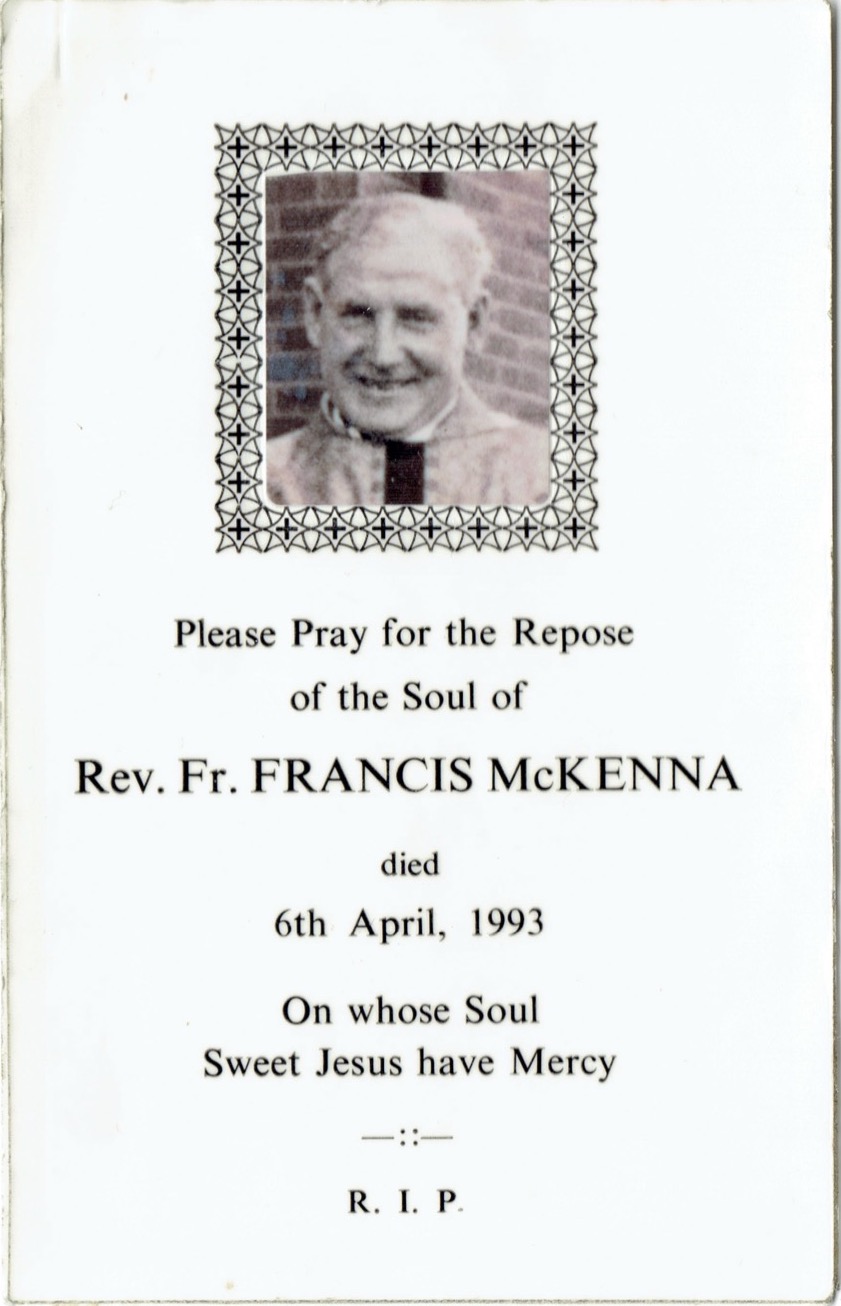 1942 – 1962
1942 – 1962
Father Francis McKenna 1942 – 1962
Fr McKenna was ordained priest by Bishop McCormack at Ushaw on 26th July 1942. Apart from his years of training, he lived the whole of his life in the City of Newcastle upon Tyne. He was born in Elswick in 1915. His first appointment was to St Anthony of Padua – an appointment that was to take up the next twenty years of his life. In 1962, he was appointed parish priest of Our Lady and St Vincent’s where he was to remain until his untimely death.
Many people will remember Fr McKenna for their own personal reasons. He was a wonderful listener and always remained open to changes and developments which inevitably occurred during his time as a priest. He always put his people first before anything else in his life. They had the first claim on his time.
Fr Francis McKenna, parish priest of Our Lady and St. Vincent’s Parish in Newcastle upon Tyne died on 6th April 1993, aged 77 years. Fr McKenna’s Funeral Mass took place on Wednesday 14th April and was followed by burial at Ashburton Cemetery, Gosforth.
1945 – 1950
Father John Hoynes
1947 – 1950
Father William Kearney
1947 – 1949
Father John Daley
1951 – 1958
Father Joseph Hardy
1951 – 1962
Father Wilfred Wright
1951 – 1952
Father James Hardy
1959 – 1962
Father Austin Tomaney
1963 – 1965
Father Edward Wilkinson
1963 – 1969
Father Richard Harriott
1963 – 1967
Father Noel Lynch
1965 – 1966
Father Joseph Rossi
Photograph of Father Rossi
1966 – 1974
Father William McKenna
Father McKenna died 23rd July 2006.
1970 – 1973
Father Joseph Travers
1973 – 2017
Father Michael Conaty
Click here for information on Father Conaty
1974 – 1977
Father James Costello
Father James Costello was ordained at St Peter’s College, Wexford, in June 1954, he moved to the diocese of Hexham and Newcastle to become assistant priest at St Lawrence’s in Byker. After six years he moved to become assistant priest at Seaham Harbour and in 1967 he moved to Bells Close. In 1972, he became priest in charge at St Thomas’, North Shields, then at St Anthony’s. In 1978 he became parish priest at St Oswald’s, Bellingham and served here until his death. He died unexpectedly at the age of 66.
1979 – 1981
Father David Taylor
1982 – 1983
Father David Hewitt
1992
Father Bob Kinlen
1993 – 1994
Father Paul Tully
2017 – 2021
Father David Smith
2021 – 2023
Father Shaun O’Neill
2023 – present
Father Jonathon Bowes
(taken from Parish Records and Northern Catholic Calendars)
